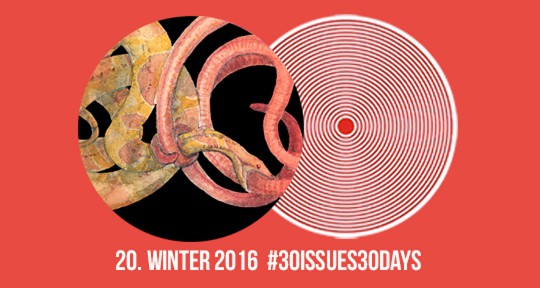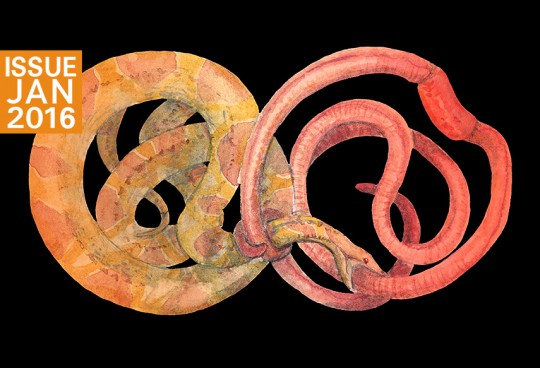Daniel Hahn’s Ask a Translator column, in which he fields questions about his craft posed by Asymptote readers, kicks off at the blog. What should have been a happy occasion (our fifth anniversary, celebrated in New York, London, Hong Kong, Ottawa, Chicago, and Belgrade) is marred somewhat by a quarrel with one of our partner institutions. I should first note that the success of the past year (2015) has been a true double-edged sword: although it has bestowed greater visibility (which has in turn brought us partnerships with hitherto-undreamt-of international reach—all the better, I suppose, to catalyse the transmission of literature), our own team members are more coveted by other organizations as a result. Since these are paying organizations (either non-profits with institutional backing or for-profit companies with commercial viability), Asymptote can’t compete. With success also comes assumption that our coffers are being filled to the brim by sponsors and we should be spreading the wealth around. Yet, we are essentially still going it alone; I’m still working full-time without pay and channelling funds raised into web development costs, translation contests, and marketing the work that we’ve been entrusted with. Someone from a partner organization turns down an invitation to moderate our New York event for fear of being interpreted as endorsing our policy of not paying contributors; he demands that we start doing so. Should implies can, but the reality isn’t so. Still, it’s wonderful that translators have such a fierce advocate in this person; I wish editors at publications like ours also had organizations and movements behind them too. Here to introduce the Winter 2016 issue is Assistant Editor Lindsay Semel.
I was recruited as one of Asymptote’s Educational Arm Assistants in January of 2016, just around the time this issue launched. What I want to share now is a story about my first weeks with the journal and my reckoning with the Winter 2016 issue that is ultimately a defense of inefficiency and the impostor syndrome.
Even two-and-a-half years later, I still know this issue more intimately than any other, because when I came aboard as a recent undergrad (it’s not atypical for Asymptote team members to be a bit green) I felt I’d been given two unique gifts. The first, bafflingly, was the complete confidence of our editor-in-chief, Lee Yew Leong. As far as the Educational Arm was concerned, I was free to take on whatever naïve dreams I could imagine—as long as the final product met the standards of the journal. My first spicy taste of impostor syndrome—now a familiar one when negotiating Asymptote assignments—came from the simple fact that I wasn’t a teacher. I could identify with Yann Martel when he said in his interview:
I’m a messy, untutored blunderer. I might have been left to my ways if it hadn’t been for the bizarre success of Life of Pi, which—among many other consequences—brought me to the attention of many fine, sharp-minded editors. One of my editors, for example, is J. M. Coetzee’s editor. Another regularly works with Rushdie. Well, these kinds of readers call your every bluff, follow your every line of argument, weigh every word you write. So these are not craven compromises. They’re escapes from indulgences, narrow misses with non sequiturs, rescues from repetition, and so on.
The second gift, I soon discovered, lay in the creation of the Educators’ Guide. The fledgling Educational Arm was on the verge of being abandoned completely, and we had only the vaguest notion of what an Educators’ Guide might be or who might use it. But here’s why the task, at the time, felt like such a gift: producing the Educators’ Guide is an act of translation itself. To translate is the most intimate act of reading, so I spent hours and hours lovingly poring over every article, taking notes, researching context, choosing my favorite passages, learning some almost by heart. I skimmed nothing.
At the time, I was living in Jerusalem and working as an au pair for one of my former professors (another gift, as it turns out, for a student trying to create something useful for teachers) and split my study of the magazine between my two favorite cafes: one on the East side of the city, where I went when I had a free morning and could start the long trek before the sun had fully risen; and the other on the city’s west side, which I visited when I had a free afternoon and was already exhausted from looking after the children. During the long walks back home I would prod the memory of what I had read and turn over in my mind which points I could use to connect with my abstract audience. It was an entirely unique act of translation given its unlikely pairing of source text/language and target audience. What a gift.
I remember crying while I read A Day of Honey, a Day of Onions in a Palestinian-owned café in East Jerusalem. It tells the story of an Egyptian-Jewish girl caught up in the fallout of the Arab Nationalist movement in Egypt in the 1940s. The piece reminded me to be kind. One of my neighbors at the time was an American-Jewish woman whose father was high up in the Egyptian government at the exact moment that this play is set. While most Egyptian Jews were already in exile, he was placed under house-arrest and forced to perform his job until they found a suitable replacement. To read about the sort of fear that the young girl encounters in A Day of Honey—a fear that can lead someone to flee home and start again, more defensive, somewhere else—helped me empathize with the sensation of feeling trapped, alone,, terrified that someone who hates you might attack you at any moment. This is, sadly, the sort of fear that breeds itself into a people’s (a country’s) DNA.
The articles in the Winter 2016 issue, whose theme is Eternal Return, follow wild vectors, looping on the earthly plane while pointing outward to the divine, the unknown, and the yet-to-be-known. But I consider Frøydis Sollid Simonsen’s Every Day I Crawl Out of the Ocean to be the nerve center of the issue. It both clearly demonstrates the theme and converses with almost every other article. The title refers to the narrator’s daily routine of waking up in the morning: he starts as an amoeba and gradually evolves into a human. It speaks of her quotidian cycles but also of the entirety of life on earth, the temperatures of the universe, and the things the living do for love. See how the text simultaneously cycles within itself while reaching towards the eternal: “The squid’s forefathers remained in the sea, while ours crawled out, and yet we have each developed nearly identical eyes, the largest difference is that theirs are logically constructed, while ours are turned inside out.” This passage nods briefly to the title image of crawling out of the ocean before landing us in the mesmerizing image of our own inside-out sight.
If you go to the Edu section of the Asymptote website, you’ll notice that the archive of Educators’ Guides starts in Spring of 2016. So here’s my ode to inefficiency. Although it doesn’t appear on the website, I still have one of the final drafts of this Guide on which I spent so many meticulous hours as I looped my way through the eternal city. What strikes me now about the Winter 2016 Guide is that it was written from the perspective of a student, not a teacher. The objectives are exactly opposite. A student tries to make a point and defend it by providing evidence; a teacher liberates the student’s mind to discover innovative and engaging ideas while giving them the tools to do so rigorously (well, a girl can dream can’t she?). The issue’s Experimental Translation Feature illustrates why nothing’s gone to waste from my extraordinarily inefficient act of creation.
From Brandon Downing’s visual pastiches to River | Horse | Haiku, the feature’s sense of experimentation largely comes from divorcing sounds and symbols from meaning, interrogating them, rearranging them, and ending with something that evokes meaning in a new way. Every Day speaks to this phenomenon:
About this form and content stuff. Forms are not constant. An organism’s form, function, and appearance are not constant, the interaction between organisms is not constant. But its contents, the hidden secrets of the cell, its acids and chemical bases, those are constant. The contents of the secrets, the sequence of the codes, are not constant. The form of interactions is not constant. Yet the fact that interaction is perpetual, an infinite movement, that is constant.
Martín Fierro Ordered Alphabetically, a loose translation of both a text and an idea, exemplifies the same sort of experimentation in a way that ripples throughout the rest of the issue. A well-known Argentine epic is revived by reordering the lines alphabetically, resulting in crescendos and decrescendos achieved through the repetition of sound paced and weighted by the frequency of word usage, by punctuation and capitalization. A story with a meaning rooted in a particular culture is made more universally accessible by un-fixing the text:
All I could do was give up for dead
all the army and the regiments,
all the kinds you need—
All the sad things you’ve heard about
all the strings of his guitar.
All there was to be heard was the mewing
along the trail of love—
This cadence, this repetition of the first words of lines, echoes across the issue, infusing equally evocative, less experimental translations with this soaring sense of exploration. ‘Amnesia,’ from Dijala Hasanbegović’s Kids of War, reflects:
mine is the name given to me
my name is my own naming
my name has been stuck in
my hair, above my ear,
and I took it off, I stopped
responding to it long ago
And the nerve center, Every Day, again reaches out its tentacles:
Because you kissed me and asked: Are you in? Because you lived across the street from the party. It was practical. Because there are others worse off than me. At least five of the varieties of stick insect reproduce by self-cloning. Which means that they’re all identical, which means that they haven’t had sex for over a million years. There are others worse off than me.
Ok, so why was it again that I wanted to celebrate inefficiency and the impostor syndrome? Oh yeah, because they constitute the Y-axis of Asymptote’s familiar graph. Set against the horizontal stabilizer of best practices in management, the highest quality control standards, staff members seasoned in the art of publishing, and prestigious contributors (once themselves impostors, of course), Asymptote weighs equally the stumbling, daring hunches and the naïve passion of experimentation. If Asymptote has coordinates, these are them, climbing ever higher, aspiring always to perfection, ever closer, ever higher, never there, and never having any clue at all where there is.
Lindsay Semel, formerly the Director of our Educational Arm, is currently an Assistant Editor.
*****
Read more from our #30issues30days showcase:


